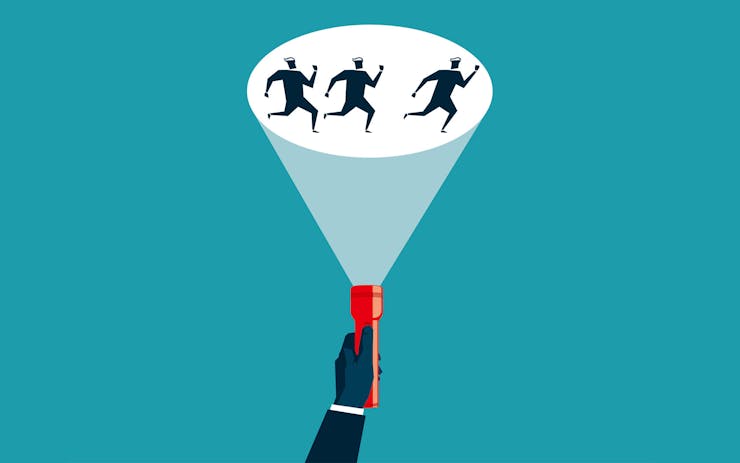To understand the history of cannabis in the United States, it’s crucial to examine immigration.
Though many people associate the war on drugs with the Nixon or Reagan administrations, the truth is that the drug war’s history dates back nearly a hundred years, to the advent of the US Border Patrol. There’s a clear historical connection between cannabis prohibition and immigration enforcement, and drug policing remains critical to border security today.
“In states with significant Mexican populations, such as Texas, Mexican prejudice was the catalyst for prohibition.”
Following the election of Donald Trump, Immigration and Customs Enforcement (ICE) has increased its use of misdemeanor cannabis convictions as a tool to arrest and deport non-US citizens, particularly at the southern border. “Nothing gets you deported quicker than a cannabis conviction,” Nick Pacheco of Latinos for Cannabis told Leafly.
On the US–Canada border, meanwhile, the government is now warning that Canadians who work in the legal cannabis industry may be barred from entering the US. Even people who simply use legal cannabis could be turned around at the nation’s borders.
Born of border enforcement
Before ICE was created in 2003, in the wake of 9/11, there was the US Border Patrol, formed by Congress in 1924 to prevent people from crossing into the US without official permission, according to Kelly Lytle Hernandez’s article “Amnesty or Abolition?” Following the Mexican Revolution, more than 890,000 Mexican people legally immigrated into the United States between 1910 and 1920.
The Border Patrol intended to police borderlands to target illegal immigrants, including Mexican migrant workers who weren’t technically prohibited from entering the US but “often evaded the administration requirements for legal entry, such as paying entrance fees and passing a literacy test and health exam,” Lytle Hernandez writes.
Around this time, the term “marijuana”—then spelled “marihuana”—entered the American lexicon. It was derived from xenophobic idea that Mexican people bring drugs into the United States.
“In states with significant Mexican populations, such as Texas, Mexican prejudice was the catalyst for prohibition,” explains Steven W. Bender, an associate dean at Seattle University School of Law, in his piece “The Colors of Cannabis: Race and Marijuana.” “As contended on the floor of the Texas Senate in the early 1900s,” he writes, “‘All Mexicans are crazy, and this [marijuana] is what makes them crazy.’”
Stigma stemming from racism
By the 1930s, long before the years of “Just Say No,” federal officials were actively working to expand the stigma around cannabis. Harry Anslinger, who during the era of alcohol prohibition had become the first commissioner of the Federal Bureau of Narcotics, “took the scientifically unsupported idea of marijuana as a violence-inducing drug, connected it to black and Hispanic people, and created a perfect package of terror to sell to the American media and public,” Bender writes. The propaganda helped push forward the Marihuana Tax Act of 1937, the first piece of national legislation to outlaw cannabis.
“With Operation Wetback, I mean, obviously it can’t get more transparent than that.”
Black men were also demonized as criminals by anti-pot rhetoric. “In Southern states with large black populations, fears of violent black smokers led to marijuana laws,” Bender added. “‘Marijuana was scapegoated as prompting murder, rape, and mayhem among blacks in the South, Mexican Americans in the Southwest, and disfavored white immigrants from laboring classes—with marijuana being blamed for the seduction of white girls by black men and for violent crimes committed by these groups.”
“It seems pretty clear that the government was using immigration laws and cannabis laws to get rid of Mexicans at different periods,” Pacheco said. “With Operation Wetback, I mean, obviously it can’t get more transparent than that in terms of what the government is doing.”
Three years after the BOGGs Act of 1951, which increased drug penalties, Operation Wetback was a 1954 campaign that ordered Border Patrol task forces to sweep across the American Southwest in order to address the so-called “wetback problem”—immigrants crossing the border illegally.
The rhetoric sounds all too familiar under the Trump administration, as the president regularly justifies a border wall to keep out Mexican immigrants. “They’re bringing drugs. They’re bringing crime. They’re rapists,” he famously said in 2015, adding: “And some, I assume, are good people.”
The origin of the Controlled Substances Act
In 1956, Congress passed the Narcotics Control Act, further escalating penalties for drug offenses. The federal drug policy that we know today didn’t start until nearly 15 years later, when Nixon signed the Controlled Substance Act. The new law categorized cannabis as a Schedule I drug—one with no medical use and a high potential for abuse—alongside heroin, LSD, MDMA, and DMT. In 1973, the federal government formed the Drug Enforcement Agency (DEA), tasked as the lead agency to enforce the CSA.
The CSA included mandatory sentencing minimums for drug crimes, removing judges’ discretion to scale down penalties in less-egregious cases. According to the Brennan Center for Justice, there are five times as many people in American prisons today compared to in 1970 because “[mandatory minimum] laws have replaced judicial discretion across a wide range of offenses. Their aim is to keep those who violate certain laws in prison for longer periods of time.”
Mandatory minimums also served to further criminalize Black and Brown communities, exacerbating the racial disparities between whites and people of color.
“We still have situations where, even in Colorado, after legalization, communities of color were still getting arrested in higher numbers than more affluent or more Caucasian communities,” Jason Ortiz of the Minority Cannabis Business Association told Leafly. “So while we actually are making progress, the root cause of the problem and the root discrepancies between communities still remain.”
Indeed, a recent investigation by the New York Times found that Black Americans were nearly 15 times more likely to be arrested in New York City for low-level cannabis crimes than their white neighbors.
Ortiz stressed that the resources from the legal cannabis market must now be funneled back into the communities that were most affected by the war on drugs. Additionally, the industry must also be representative of the people who consume cannabis and have been involved with the industry for decades—which for sure isn’t just rich, white business owners and investors.
Meanwhile, since cannabis is still a federal crime, Ortiz stresses, immigrants working in the cannabis industry—even in the legal marketplace—are at risk for deportation.
The policing of cannabis was, and still is, used to justify violent border security. We need to better understand the history of immigration enforcement and the racist motives behind the drug war in order to better address the inequalities that exist within the cannabis industry today.





